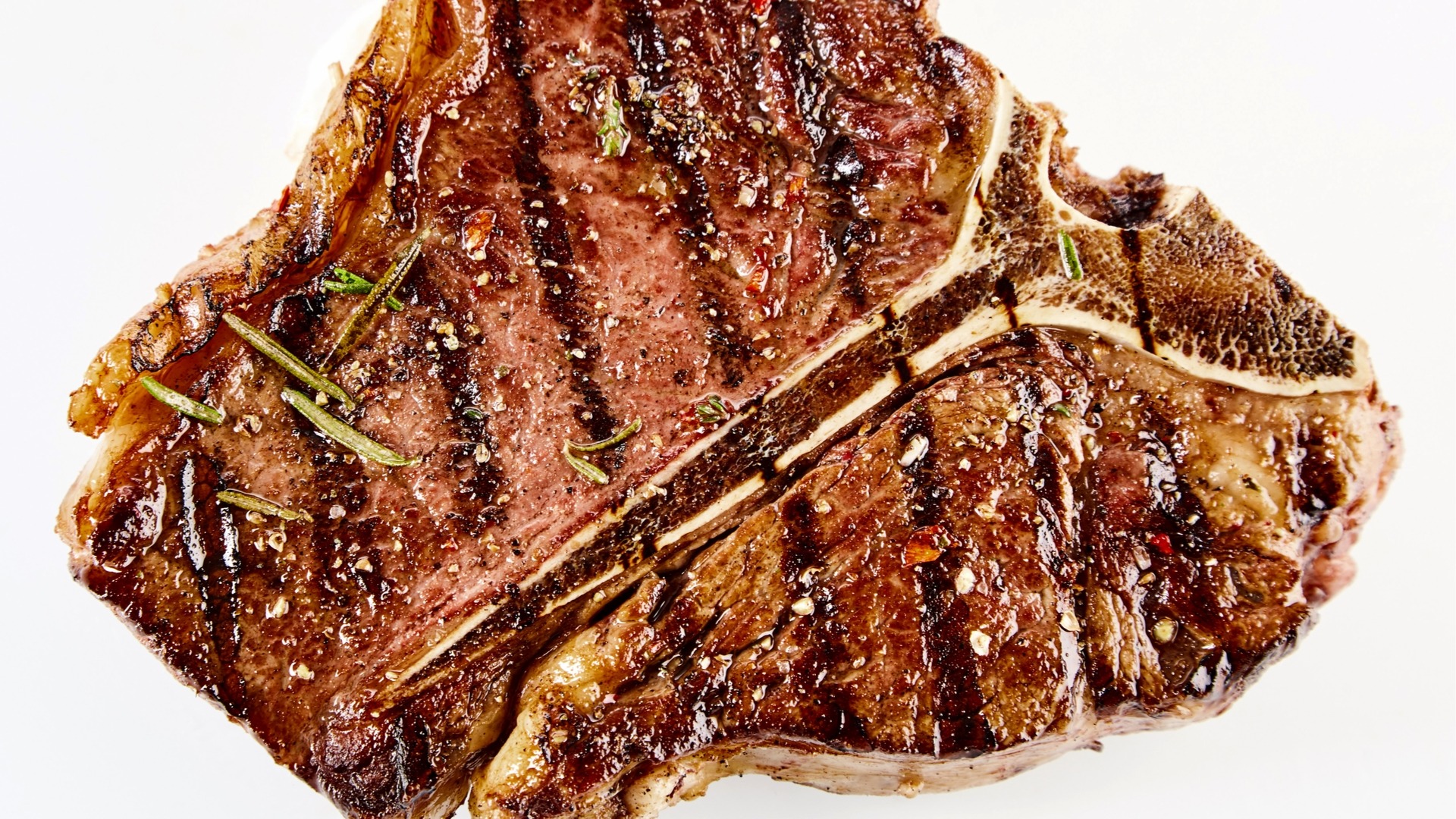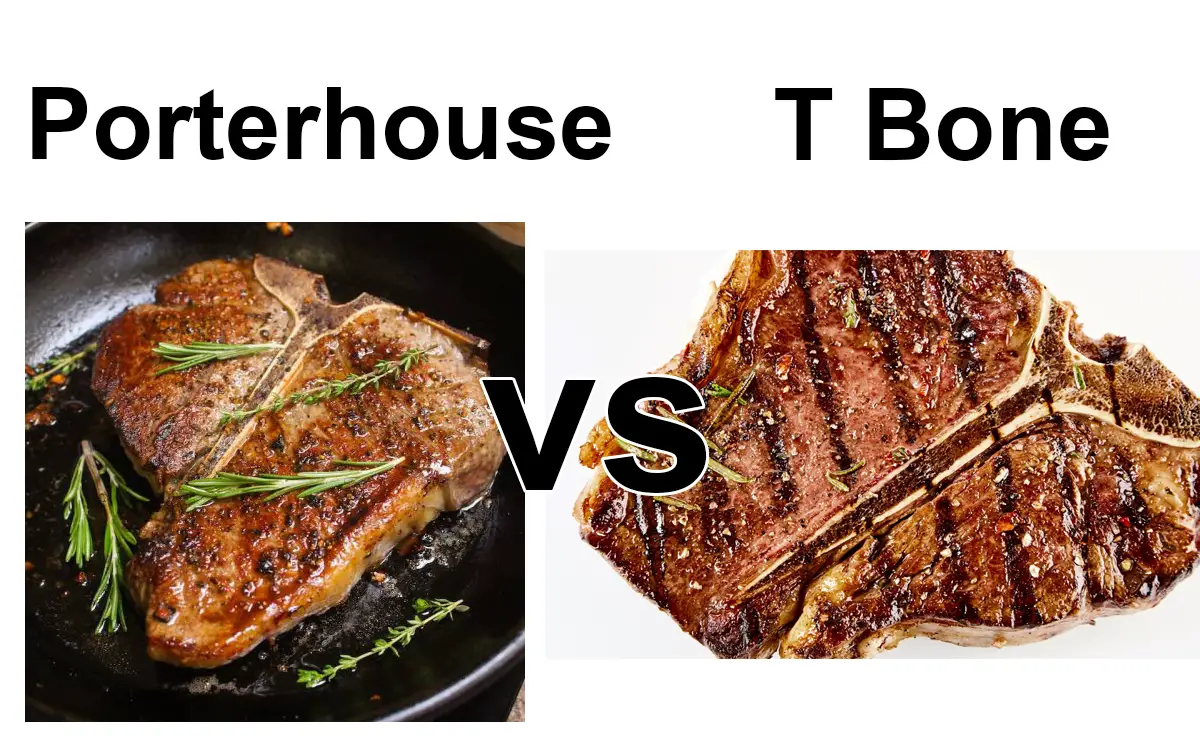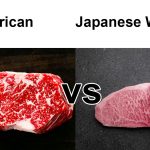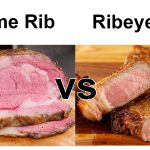Whether you’re an avid fan of steak or just learning about this classic cut of beef, the differences between porterhouse and T-bone steak can make all the difference. Both steaks have their advantages and it all boils down to preference. This blog post will break down the similarities and differences between both cuts so that you know exactly what to expect when making your dinner plans. No matter if you’re in search of maximum flavor or looking for leanest option, we’ll guide you through these iconic cuts of beef so that every bite is as delicious as possible!
What is Porterhouse?

Porterhouse steak is considered the king of steaks due to its high fat content and large size. Porterhouse steaks are cut from the rear end of the short loin, which means they contain a larger strip steak side that’s connected to a smaller tenderloin piece. This combination not only creates an impressive presentation on your plate but also packs plenty of flavor in every bite. The meat near the bone tends to be more flavorful and juicy than other cuts, making porterhouse an obvious choice for steak lovers everywhere.
Porterhouse Nutrition Facts:
A porterhouse steak is a rich, flavorful cut of beef. It comes from the muscle that runs along the backbone between the rib and sirloin area. Porterhouse steak is especially popular because it contains both tenderloin and strip steaks in one cut. It is also very high in protein, iron, zinc, selenium, phosphorus, magnesium and B vitamins.
A 3-ounce serving of cooked porterhouse steak contains approximately:
• Calories: 201
• Fat: 11 g
• Protein: 24 g
• Carbohydrates: 0 g
• Vitamin B12: 15% of the daily value (DV)
• Iron: 28% DV
• Sodium: 59 mg
• Potassium: 358 mg
• Zinc: 8% DV
• Selenium: 39% DV
• Phosphorus: 16% DV
• Magnesium: 11% DV.
Porterhouse steak is rich in healthy fats, which can help lower cholesterol levels and reduce the risk of heart disease. It’s also a great source of protein and essential vitamins and minerals that are important for proper growth, development and overall health. Eating porterhouse steak regularly can provide your body with all the nutrients it needs to stay strong and healthy.
What is T-bone?

T-bone steaks are named after their signature ‘T’ shaped bone that’s found between two different cuts of beef – the strip steak and the tenderloin. Unlike porterhouse, T-bone steaks are cut from the front end of the short loin and feature two connected pieces of meat that are not quite as large. The strip steak side contains a slightly higher fat content than the tenderloin side, which typically produces a less flavorful but leaner bite.
T bone Nutrition Facts:
A T-bone steak is a cut of beef that consists of two different types of meat – tenderloin and strip steak. It comes from the front part of the short loin, which is located between the rib and sirloin area. A 3-ounce serving of cooked T-bone steak contains approximately:
• Calories: 218
• Fat: 12 g
• Protein: 24 g
• Carbohydrates: 0 g
• Vitamin B12: 9% DV
• Iron: 25% DV
• Sodium: 59 mg
• Potassium: 366 mg
• Zinc: 8% DV
• Selenium: 39% DV
• Phosphorus: 16% DV
• Magnesium: 11% DV.
Like porterhouse steak, T-bone is a great source of healthy fats and essential vitamins and minerals. It’s also an excellent source of protein, which can help build muscle and promote weight loss. Eating T-bone steak regularly can provide your body with all the nutrients it needs to stay strong and healthy. Both porterhouse and T-bone steaks are delicious cuts of beef that offer several health benefits when eaten in moderation. They are both high in cholesterol, so be sure to keep portion sizes small to avoid overindulging.
What’s The Difference Between Porterhouse and T-Bone Steak
At first glance, it may seem like these two cuts of beef have much in common – but that couldn’t be further from the truth! Porterhouse and T-bone steaks differ in size, fat content, flavor intensity and overall texture. Here’s a quick breakdown:
• Size: Porterhouse steak is larger than T-bone, as it’s cut from the rear end of the short loin.
• Fat Content: Porterhouse has more fat than T-bone and is usually juicier due to its higher fat content.
• Flavor Intensity: Porterhouse steak has a bolder flavor profile that’s often associated with steak, while T-bone steak has a milder taste.
• Texture: Porterhouse steaks tend to be tender and juicy, while T-bone steaks can be on the tougher side depending on cooking methods.
Now that you know the difference between porterhouse and T-bone steaks it’s time to hit up your local butcher shop and get cooking! Whether you’re in search of maximum flavor or looking for a leaner option, these two steak cuts are sure to satisfy even the pickiest palates.

Porterhouse and a T bone: What’re The Similarities?
Both porterhouse and T-bone steaks are cut from the same area of the cow, making them similar in many ways. Here’s a quick overview of their similarities:
• They come from prime cuts of beef found in the short loin region.
• Both boast tender texture and delicious flavor.
• They offer high levels of essential vitamins and minerals.
• Both provide a good source of healthy fats.
• Porterhouse and T-bone steak both contain around 24g of protein per 3 oz serving.
Porterhouse and a T bone: Which Is Better?
The answer to this question depends on several factors, such as your personal preference and dietary needs. Porterhouse steak is larger than T-bone, so it can be a good option if you’re looking for more meat in a single cut. However, since it’s higher in fat content, it may not be the best choice for those trying to watch their caloric intake. Additionally, porterhouse steaks are usually more expensive than T-bones.
On the other hand, T-bone steak has a milder flavor profile and contains less fat – making it a popular choice among health conscious individuals. It also tends to be more affordable than porterhouse and offers its own unique texture that many people enjoy. Ultimately, the choice is up to you!
Porterhouse and a T bone: What About Flavor?
Although both porterhouse and T-bone steaks offer a delicious flavor, there are some subtle differences to consider. Porterhouse is typically more flavorful due to its higher fat content, while T-bone steak offers a milder taste. Additionally, the texture of porterhouse steak can be described as juicy and tender, while T-bone steak has a firmer consistency.
What’s more expensive, T-bone or porterhouse?
Porterhouse steak is usually more expensive than T-bone, although the price difference will vary depending on where you’re buying. Generally speaking, porterhouse steaks are pricier due to their larger size and higher fat content. However, they often offer a juicier texture and more intense flavor than T-bone steaks.
How To Cook A Porterhouse:
it comes to cooking a Porterhouse steak, one of the most important things to keep mind is that they require low and slow heat for optimal results. Here’s how to get started:
• Preheat your oven or grill to 250°F.
• Season liberally with salt and pepper.
• Place your Porterhouse steak on the preheated surface fat side down first and cook for 5 minutes per side.
• Flip your steak and reduce the heat to 200°F. Cook for an additional 10-15 minutes, flipping halfway through until desired doneness is achieved (we recommend medium rare).
• Let your steak rest for 5-10 minutes before slicing into it.
How To Cook T Bone:
Cooking T-bone steak is similar to cooking a Porterhouse, but due to its smaller size, you may need less time. Here’s how to get started:
• Preheat your oven or grill to 275°F.
• Season liberally with salt and pepper.
• Place your T-bone steak on the preheated surface fat side down first and cook for 3 minutes per side.
• Flip your steak and reduce the heat to 225°F. Cook for an additional 8-10 minutes, flipping halfway through until desired doneness is achieved (we recommend medium rare).
• Let your steak rest for 5-10 minutes before slicing into it.
Tips For Selecting The Best Porterhouse And T-Bone Steak:
• Look for steaks that are at least 1½ inches thick and have some good marbling throughout.
• Make sure that the fat content is evenly distributed this will ensure an even cooking process and maximum flavor.
• Try to choose organic beef if possible, as it tends to have more flavor and a better texture.
• Check the color of the steak it should be bright red in color with no discoloration or brown spots.
• Smell the steak—it should have a mild aroma of fresh beef with no off-odors.
• Feel the steak for any signs of grittiness or sliminess—these can indicate poor quality meat.
• Avoid any steaks that have been pre-cut, as this may affect their tenderness and flavor.
Common Mistakes To Avoid When Cooking Porterhouse and a T bone
• Not allowing your steaks to rest before slicing: Resting allows the meat to cool slightly and redistribute its juices, so it’s important to give them a few minutes before cutting into them.
• Overcooking: Porterhouse and T-bone steaks should be cooked at low heat for optimal results overcooking will result in dry, tough meat.
• Not seasoning properly: Always season your steaks with salt and pepper for flavor. Additionally, feel free to add your favorite herbs and spices if desired.
• Cutting across the grain: When you slice into your steak, make sure you’re doing it with the grain (lengthwise) rather than against the grain (across). ensures that each bite is tender and not chewy.
FAQs Porterhouse vs T Bone Steak
What is the difference between porterhouse and a T-bone?
The main difference between a porterhouse and a T-bone steak is size. Porterhouse steaks are larger, containing both the tenderloin and strip sections of meat separated by a “T” shaped bone, while T-bones contain only the strip section separated by a similar “T” shaped bone. Additionally, porterhouse typically has more fat content than T-bone which gives it a richer flavor and juicier texture.
What temperature should I cook my porterhouse or T-bone at?
For optimal results, your Porterhouse should be cooked at 250°F, and your T-bone should be cooked at 275°F. Make sure to reduce the temperature for both steaks when flipping them to ensure even cooking. However, always adjust the temperature accordingly depending on the thickness of your steaks.
How long do I need to rest my steak after cooking it?
We recommend letting your steak rest for 5-10 minutes before slicing into it. This will allow the meat to cool slightly and redistribute its juices, so you get a juicy and tender bite every time.
Are T-bone and Porterhouse steaks the same?
No, while they are both cuts of beef steak that include the tenderloin and strip sections of meat separated by a “T” shaped bone, Porterhouse steaks typically contain more fat content and have a larger size than T-bone steaks. Additionally, porterhouse offers a juicier texture and more intense flavor than T-bone steaks.
Is it better to cook porterhouse or T-bone on the grill?
Both steaks can be cooked on the grill. However, make sure to use low heat and keep an eye on them as they cook as overcooking will result in dry, tough meat. Additionally, it’s important to let your steak rest for 5-10 minutes after cooking before slicing into it.
Is T-bone or Porterhouse more tender?
Porterhouse is typically more tender than T-bone because it has more fat content which gives it a richer flavor and juicier texture. Additionally, Porterhouse steaks are typically larger in size meaning they have thicker cuts of meat which can lead to a more tender steak. However, both types of steak can be cooked perfectly if done properly.
What’s the best way to slice my steak?
Make sure that when you’re slicing your steak, you do it with the grain (lengthwise) rather than against the grain (across). This ensures that each bite is tender and not chewy.
Can I marinate my Porterhouse or T-bone?
Absolutely! Marinating your steaks can help add more flavor and tenderize the meat. Be sure to marinate them in an acid-based marinade for at least an hour before cooking. However, it’s important to note that if you marinate your steak for too long, it can become mushy and not as flavorful.
How do I know when my Porterhouse or T-bone is done?
The best way to check if your steak is done is by using a thermometer. For medium rare, you should aim for an internal temperature of 135°F. If you don’t have a thermometer, poke the thickest area with your finger and assess the texture—it should be slightly springy but still tender.
When your steaks reach desired doneness, remove them from heat and let rest for 5-10 minutes before slicing into them. This will allow the meat to cool slightly and redistribute its juices, so you get a juicy and tender bite every time.
Conclusion
All in all, the differences between porterhouse and T-Bone steaks are subtle but significant. Porterhouse steaks contain more of the all-important tenderloin muscle, which makes them more succulent than their more affordable cousin, the T-Bone steak.
However, when cooked to perfection and carefully handled a T-Bone steak can still deliver some beautifully juicy meat with an intense beefy flavor perfectly complemented by the crispy crust of a well-made steak. Ultimately, it’s up to you to decide which steak is most suitable for your own tastes and budget both offer exceptional value and taste that will delight even the pickiest of customers!

William Lariviere is a chef and restaurateur with over 25 years of experience in the food industry. He is the owner and operator of Swartzsdeli.com, an online restaurant that specializes in gourmet sandwiches and salads, grill & smoke. He likes to share experience, food, recipes cooking knowledge as well as reviews about restaurant and kitchen products.
William’s goal is to provide his customers with healthy, delicious food that is also affordable and develop Swartzsdeli.com into a comprehensive information site specializing in cooking and cuisine to a new level to help reach a wide range of housewives and readers.








